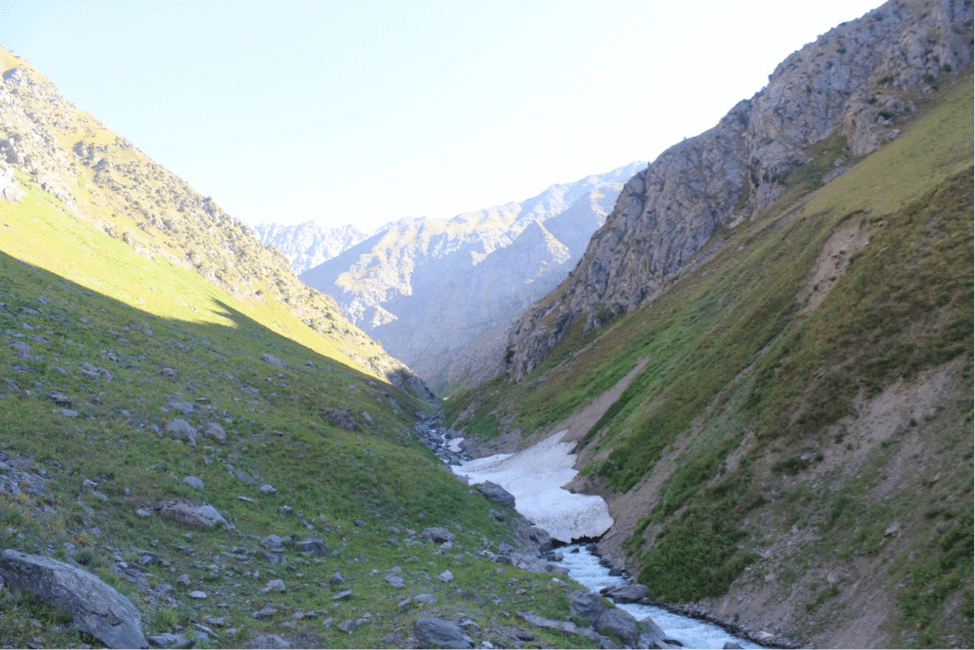
Hisar ridge, Kanask gorge, Tajikistan (height 2300-2500 m. above sea level)
In 2020 the project contributed significantly to the implementation of national strategies in the field of biodiversity conservation and national policies on environment protection, and relevant achievements were reported to the CoEP and the Government on a quarterly basis and further included in policies and practices related to national sustainable development documents. With the support at the policy level, the project succeeded to obtain permissions for construction of environmental objects and facilities in the areas of snow leopard ecosystems. On the instruction and under consultations of the Committee for Environmental Protection, the project provided support and was directly engaged in producing a number of videos about life activities of snow leopards and wild ungulates (snow leopard prey species). These and other notable project results and best environmental practices have been included in a number of environmental programs and in plans for establishing wildlife conservation facilities.
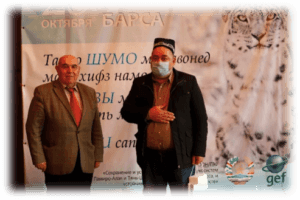
D.b.s. Professor Safarov N.M. and Fayzov Ismoil-project partner
The progress was made through improved capacity of protected areas, enhanced forest and pasture management in Hissar-Alay and Vakhsh-Darvaz areas, capacitation of environmental staff in wildlife enforcement and continued online regional and transboundary consultations on snow leopard ecosystem conservation. The project gained significant results in capacitating ranger and administration staff of targeted protected areas (Sangvor and Lakhsh sections of Tajik National Park), implementing the SMART patrol system and enhancing community evolvement in cooperation with protected areas. For the first time the boundaries of the Sangvor zakaznik have been indicated through the installation of 30 banners, signs and pointers along the borders of Sangvor and Lakhsh sections of Tajik National Park. 2 checkpoints and boom gates were installed at the entry points of Sangvor section to enhance protection and control of visitors to the park.
To enhance staffing and patrolling capacities 18 rangers in Sangvor and Lakhsh sections of Tajik National Park were supported with proportion of a monthly salary; the PA staff was equipped with communication equipment (phones, radios, tablets), furniture and equipment for smart patrolling. Along with that, as the result of 20 capacitating workshops and trainings, 200 individuals improved their skills in the principles of monitoring, smart patrolling, inventory of wild animals, and suppressing poaching. Within the activities of deploying the smart patrol system, supported by international provider the NextGIS company, more than 80 individuals were trained in methods of smart patrolling and monitoring. At present, this is the only system of thematic control and monitoring in protected areas; and the relevant works on introducing the smart patrol system are carried out for the first time in the history of Tajikistan.

NPA Staff, Smart patrolling training
In terms of engaging communities, the project succeeded to engage more than 2,000 people, including 500 women, trough awareness raising campaigns, and improved their knowledge about snow leopard and prey conservation, and the opportunities for cooperation with protected areas.
Project partners conducted 20 workshops with the participation of 400 people from Pasture Users Unions on methods of restoration/reha-bilitation and management of high-altitude pastures and forests. 3 Participatory Forest Management committees were involved in planning, management and monitoring of Hissar-Alai and Vakhsh-Darvaz highland forests.
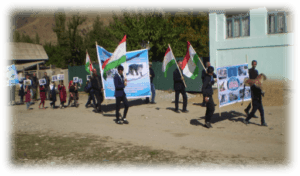
Snow Leopard parade in Rasht district for raising awareness
In terms of monitoring and enforcement in the areas outside of PAs the project facilitated development of a training program on monitoring and law enforcement and conducted more than 50 seminars and trainings for representatives of environmental agencies of the CEP and forestry departments, who improved their knowledge and skills in monitoring and law enforcement, restoration of pastures and forests in the snow leopard habitats. Along with that a Wildlife Monitoring Center was built in Sarikhosor Jamoat, and equipment, furniture and alternative energy efficient technologies were procured to equip the Center.
Under Component 3 on regional cooperation, the project facilitated development of standard procedures for the study and monitoring of snow leopard ecosystems and the structure of unified methods for assessing the condition of large animal species in high-mountain ecosystems. Relevant workshops and trainings on the principles of SLIM monitoring were offered in Dushanbe, Kulob, Bokhtar, Shurabad and Shakhrinav. The issues of using SLIM monitoring were also discussed at the online meeting of the GSLEP with participation of Tajikistan, Afghanistan, Bhutan, China, India, Kazakhstan, Mongolia, Pakistan, Uzbekistan, Russian Federation and international organizations such as the International Snow Leopard Fund, and UNDP.
One of significant project achievements in 2020 became the progress on adopting the Central Asian Memorandum on conservation of snow
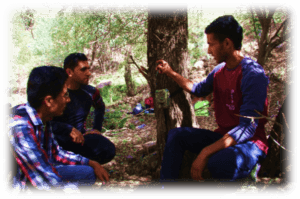
Installation of camera trap in Shirkent
leopard, its prey, landscapes and ecosystems in Western Tien-Shan and Pamir Alai, which has been approved by the Decree of the Government of Tajikistan No. 546 on 27 October 2020. In 2020, the project and its partners (within the agreements concluded to cover wider area by monitoring and other activities) supported installation of 70 camera traps in natural protected areas and reserves (in 8 project areas).
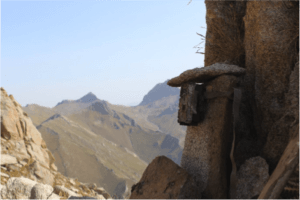
Installed photo trap in Zarkamar gorge, (height 3850 m above sea level)
In December 2019 – February 2020 the project Midterm review was held, including the on-site evaluation of project progress in the distant areas of Pamir, Darvoz, Kulyab zone, Rasht, Zeravshan, Shahristan. The results of the review highlighted the project success in delivering its planned activities, noting that the implementation of the project is adhering to its strategy designed at the outset. It was also noted that the fact that the project is implemented by the NBBC is also a success factor leading to a good national ownership of the project. Altogether 12 recommendations were made as the result of the Midterm review, which included expanding communication on project results and lessons learnt, strengthening staffing capacities in remote project target areas, strengthening collaboration with neighbouring countries on transboundary cooperation, and expanding the project grant component to ensure better coverage in the communities. In accordance with the management response plan the set of recommendations have been consistently implemented throughout the year and the progress has been reported to both UNDP CO and the Istanbul Regional Hub.
Project Results and Impact Summary
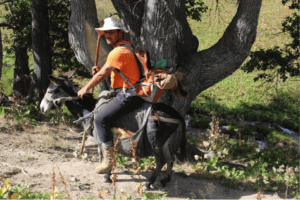
Hike in hard-to-reach mountains for monitoring of snow leopard
During the reporting period, the project prepared the necessary regulatory documents to include Sangvor Zakaznik in the Tajik National Park. The package of documents on upgrading the status of Sangvor Zakaznik was submitted to the Committee for Environmental Protection (CoEP) for review and approval. The area of protected areas falling under IUCN Category I and Category II is 2777018 ha, and will increase up to 2,837,018 ha once Sangvor Zakaznik is included into the Sangvor Section of the Tajik National Park.
40% of Lakhsh and 50% of Sangvor Tajik National Park sections are under safe and effective monitoring and enforcement regime.
More than 500 people (80 of them women), including 18 rangers and 2 community liaison experts financially benefit from participation in PA protection and patrolling, as well as enjoy favourable terms for collection of forest resources, firewood, medicinal herbs, beekeeping and use of pastures in Lakhsh and Sangvor sections of TNP.
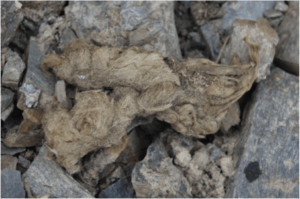
Traces of a snow leopard, Zarkamar gorge, (height 3850 m above sea level)
In 2020, due to favourable climatic conditions (intensive snow and rainfall in the mountains) and late transfer of cattle to high-altitude pastures, the days of grazing reduced by 20-30 days in winter pastures and by 30-40 days in summer pastures.
According to expert field assessments and reconnaissance research, the productivity of high mountain pastures in the project areas of Hissar-Alay and Vakhsh-Darvaz ranges from 4.4 to 5.8 tons per hectare.
According to project experts, 40-60% of the total grass cover on the high mountain pastures of Hissar-Alay and Vakhsh-Darvaz make the species edible for wild animals and livestock. The percentage of eatable and edible species was identified using the moving method in selected plots.
During 2020, 150 hectares of high-altitude pastures and 42 hectares of high-altitude forests were restored by pasture user unions and forest departments in 10 project areas.
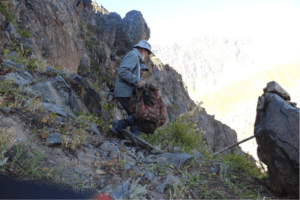
Snow leopard range monitoring, Hisar ridge, Tajikistan (height 3 450 m. above sea level)
During the reporting period (2020 year), 2,000 ha of high-altitude pastures in Shahristan, Ayni, Rasht, Tojikobod, Lakhsh, Sangvor, Muminobod, Khovaling and Shamsiddin Shokhin districts have been restored and are under sustainable management.
The standard procedures for the study and monitoring of snow leopard ecosystems were developed and the structure of unified methods for assessing the state and relative abundance of large animal species in high-mountain ecosystems. Workshops and trainings have been conducted in Dushanbe, Kulyab, Bokhtar, Shurabad and Shakhrinav to teach the principles of SLIM monitoring and its introduction.
National Action Plan on conservation of snow leopard ecosystems (NAP) has been updated against the background of new global programs on “Biodiversity, socio-economic assessment, sustainable development etc.”.
Under 4 programs of the Action Plan, activities are being implemented with partners (strengthening the potential of partners, using innovative technologies, reducing the risk of poaching, and developing research and monitoring programs for wild ungulates and snow leopards).
By the Decree of the Government of the Republic of Tajikistan No. 546 dated October 27, 2020, the Agreement of the Central Asian countries on snow leopards was ratified.
Knowledge resources on snow leopard and project achievements have been demonstrated at more than 14 national workshops in (districts in Tajikistan) Rasht, Aini, Shahristan, Dashtijum, Shakhrinav, Lakhsh, Sangvor, Shurabad districts and the cities of Bokhtar, Kulyab, Khujand and Khorog, and 2 conferences (1 on tourism and 1 conference dedicated to International Snow Leopard Day). The achievements of the project were demonstrated in 2 international webinars (workshops) on gender and environment issues.
As of today, national coverage of snow leopard and prey monitoring activities reached 25% of snow leopard range and 20% of its prey range.
Small grants program
During the reporting period (2020), the project small grants program supported three (3) community projects in Ayni and Shamsiddin-Shokhin districts aimed at restoring pastures and introducing alternative energy technologies:
(a) Sustainable pasture management:
– 13 households in Dashtijum village of Shamsiddin-Shokhin district benefit from a grant project on building corrals for 600 small cattle (10 direct beneficiaries, including 5 women, and 30 indirect beneficiaries, including 12 women).
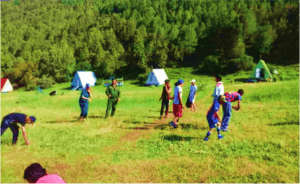
clearing of the pasture
– 40 households in the Dashtijum Jamoat of the Shamsiddin Shokhin district benefit from grant project on restoration of 4 hectares of degraded forest ecosystems and 6 hectares of pastures located in snow leopard habitats (25 direct beneficiaries and 220 indirect beneficiaries, including 75 women).
(b) Fuel and energy technologies: 508 people directly and 24,894 indirectly (including 12,355 women) benefit from a grant project on creation of a demonstration site for energy-efficiency technologies at the boarding school in Mehron village, Gorno-Machinsky district, where solar batteries and water heaters were installed.
60 people, including 14 women from pasture user unions, local communities and dekhkan farms in Rasht, Khujand and Kulob districts, were trained in the requirements and rules of preparing small grant project proposals and participating in small grant projects during three training workshops offered by the project.
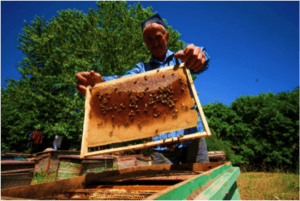
Beekeeping, one of the alternative sources of income.
Along with that, as recommended by the project Mid-term Review, in 2020 the next extended cycle of project small grants has been lunched, covering 12 SGP projects addressing the thematic areas as follows: sustainable pasture and forest management and restoration, reducing conflicts between wildlife and humans in snow leopards’ habitats, alternative sources of income.
Cooperation with GEF Small Grant Program in Tajikistan “BIG CATS”
UNDP/GEF project “Conservation and Sustainable Use of Pamir Alay and Tien Shan Ecosystems for Snow Leopard Protection and Sustainable Community Livelihoods” in Tajikistan has maintained close cooperation with the GEF SGP «Big Cats» project, which operated from March 1 to December 30, 2020. During the implementation of «Big Cats» project we have maintained constant cooperation in order to exchange experience and identify priority activities for the SGP. Currently, we are planning to organize study tours to the project areas of the GEF «Big Cats» to enhance the knowledge and experience of our beneficiaries.


